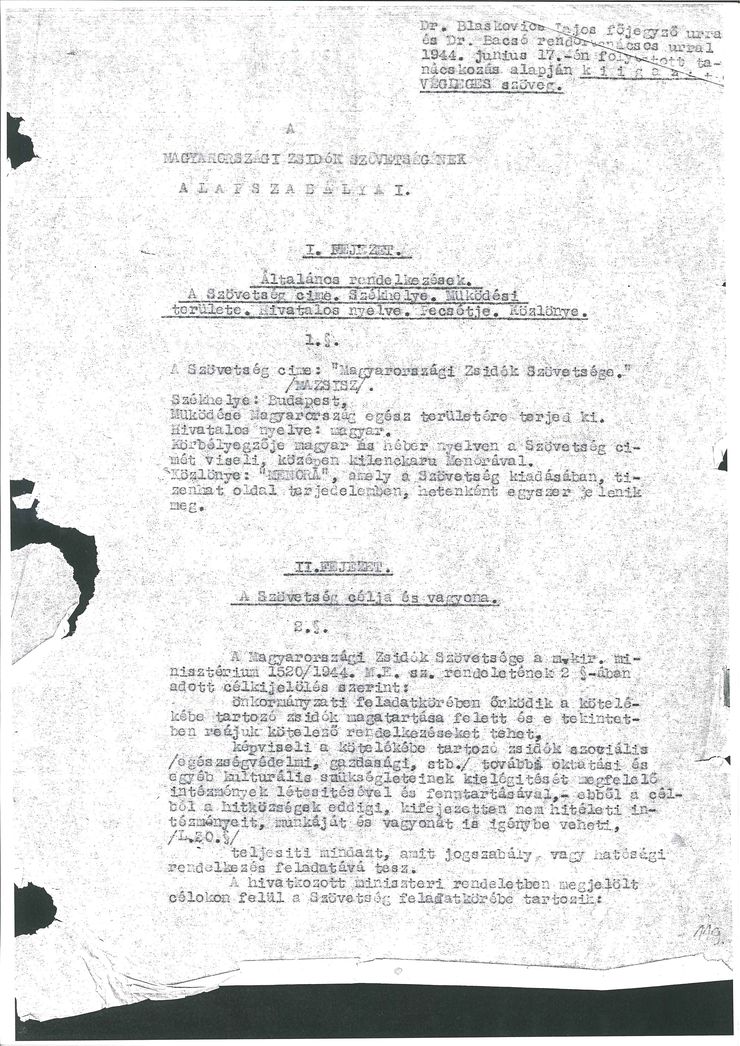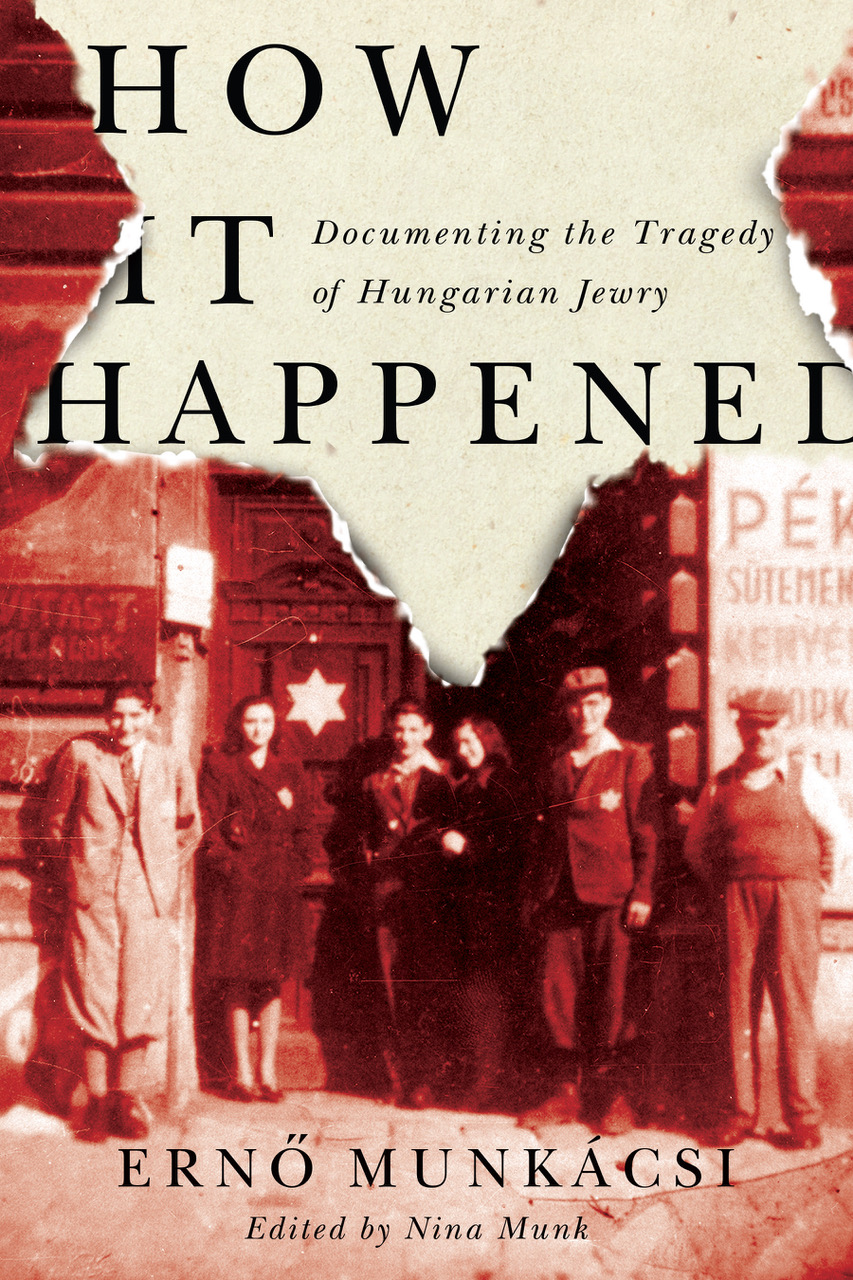Introduction
This blog post is devoted to the key publication and original sources of one of the major eyewitness chroniclers of the Holocaust in Hungary. In his book of 1947, Ernő Munkácsi, a leading official of the Jewish Congregation of Pest and the original chief secretary of the Hungarian Central Jewish Council, developed his interpretation of the devastating months of March through October 1944, the period marked by the most intensive murder campaign of the Holocaust. First published in instalments in the Hungarian Jewish weekly Új Élet (New Life) in 1946, Munkácsi’s account chiefly aimed at explaining (and defending) the Jewish leadership’s role and strategy during the war, a topic that has ever since sparked bitter controversy among survivors and historians.
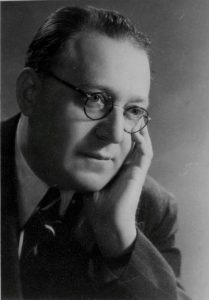
Munkácsi’s account of events was based not only on his first hand experiences and access to inside information, but also on the documents obtained from the National Office of Hungarian Israelites and the Central Jewish Council, some of which are featured in this blog post.
Please follow the links for the collection descriptions in the EHRI portal:
Statutes of the Association of Jews in Hungary (Central Jewish Council)
Documents of the Central Council of Hungarian Jews
The first excerpt below is from the new critical edition of Ernő Munkácsi’s How It Happened: Documenting the Tragedy of Hungarian Jewry, translated by Péter Balikó Lengyel and edited by Nina Munk with annotations by László Csősz and Ferenc Laczó. The second excerpt is from the book’s introduction, “The Excruciating Dilemmas of Ernő Munkácsi,” by Ferenc Laczó.
It is hoped that the English-language translation of this key publication will contribute to a long overdue rediscovery of the rich and varied responses to persecution and extermination by members of a major European Jewish community and bring a new international appreciation of the excruciating dilemmas its surviving representatives had to confront during and right after the Holocaust.
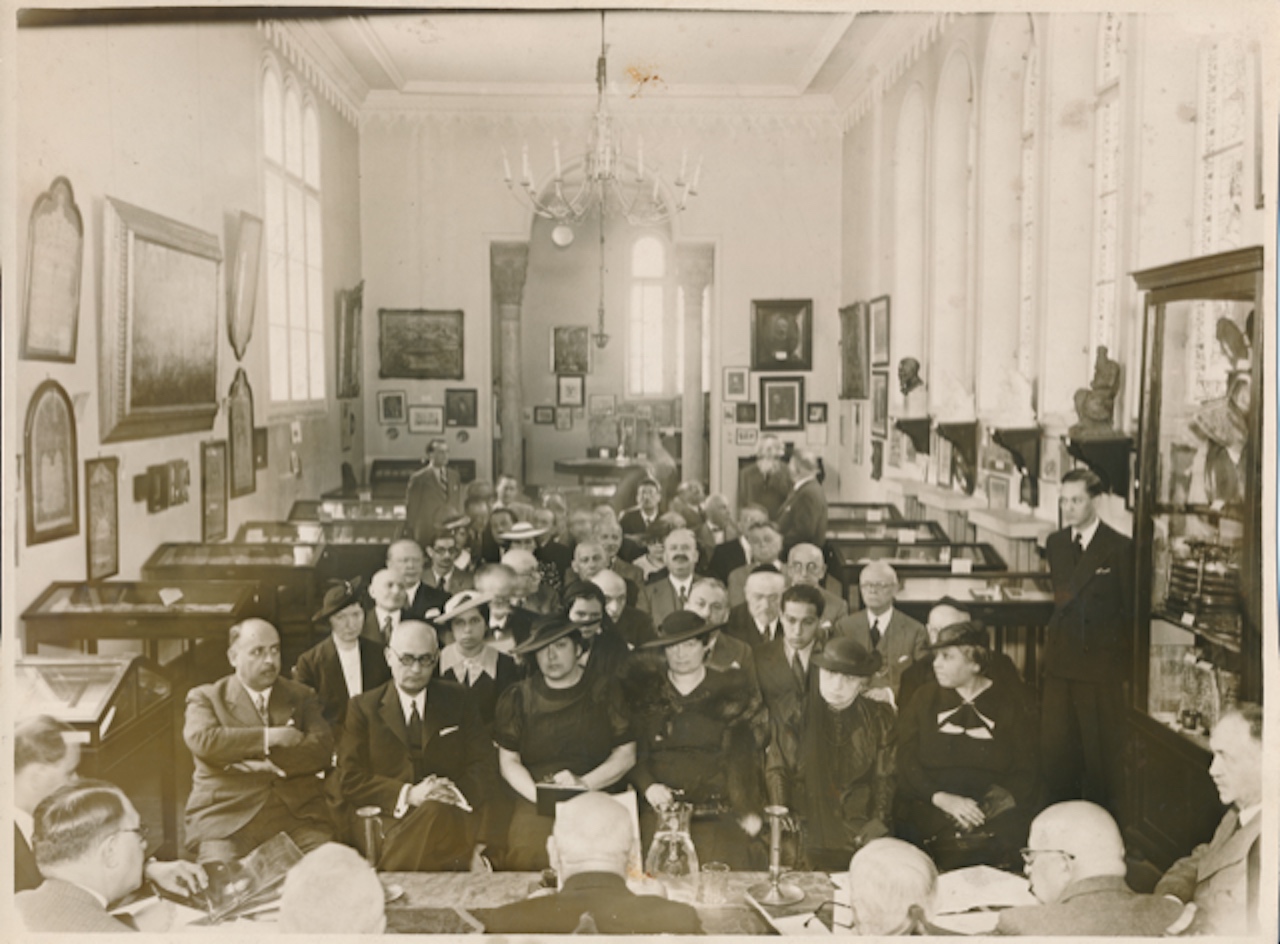
Founded in 1909 as a small collection of Hungarian Judaica, and exhibited in a private apartment in Budapest, the Hungarian Jewish Museum encompassed more than 5,000 objects and documents by 1932 when it moved into its current location behind the Dohány Street Synagogue. At this assembly for the Jewish Museum Association, in one of the main exhibition halls, Ernő Munkácsi, the museum’s de facto director from 1931 to 1945, is on the dais in the foreground, in profile at the far left.
Munkácsi’s narrative begins with the German invasion of 19 March 1944 when, amid news of Wehrmacht troops blazing their way toward Budapest, the leadership of the Pest Jewish congregation was preparing its general assembly with “gloomy premonitions.” After the hastily held meeting dominated by a conflict between the established leadership and the Zionist opposition, all participants rushed home as, in the words of the author, “the rumble of German tanks and vehicles advancing down the boulevards could barely drown cries of Heil Hitler from the scum of the city.“
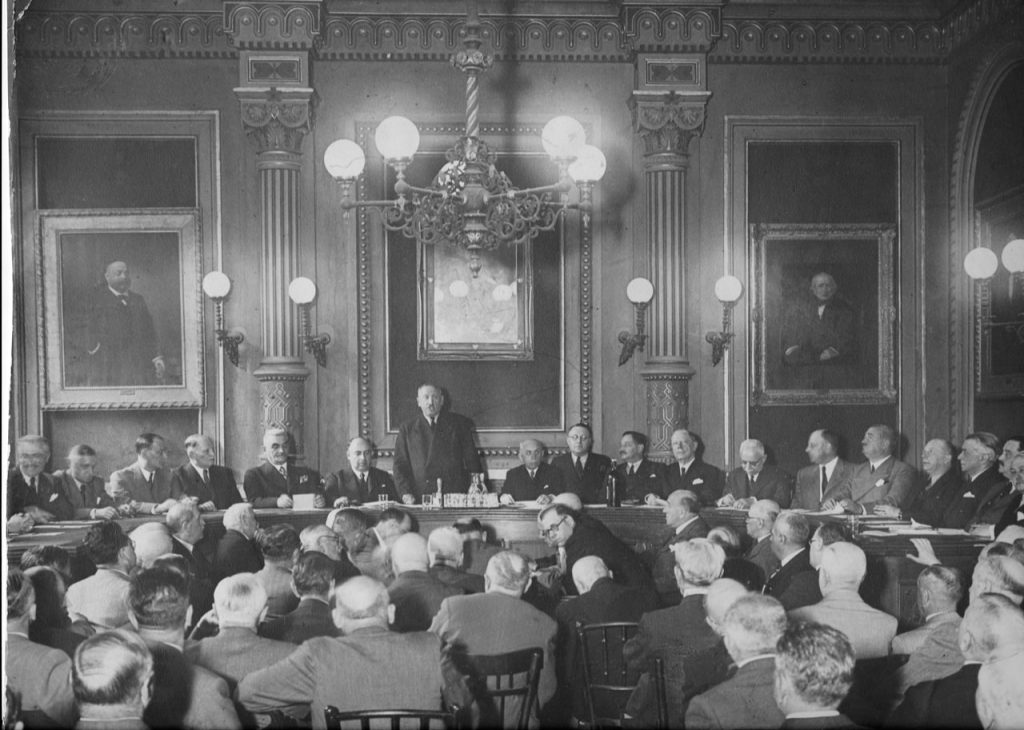
On the wall at left is a portrait of the tradesman and banker Mór Wahrmann (1832-1892), the first Jew elected to the Hungarian Parliament in 1869. On the right side hangs the portrait of Wolf “Sáje” Schossberger, the president of the congregation between 1869 and 1871. The small man with white moustache on the dais next to the speaker is President Samu Stern. Seated next to him is Ernő Munkácsi, then Chief Counsel and Secretary of the Pest Congregation.
Ernő Munkácsi: How It Happened
Around half past four that day, the phone in my apartment rang again. It was the anxious voice of Mrs Á.Cs., the supervisor of hourly paid scribes.[1] She said she needed to come to my place immediately because of events she did not want to discuss over the phone. She showed up on my doorstep in fifteen minutes. She told me about cream-coloured German cars pulling up in front of the [Pest Israelite Congregation] headquarters. Two officers [Hermann Krumey and Dieter Wisliceny] seemingly of high rank disembarked and entered the premises, demanding to know where the prefecture was. She explained to them there were no office hours on Sunday afternoons and that no senior officials were around. “Don’t be scared,” said the officers, who must have seen how frightened she was. “I am not scared,” the head clerk answered with a smile. “Wir sind Kameraden,” [we are comrades] she added quickly, as befits the wife of a decorated lieutenant. (This single sentence condensed the infinite naïveté and ruinous, unfounded optimism of the Jews of Budapest, and perhaps of the whole country.)
Finally, the Gestapo officers ordered the clerk to make sure that all senior officials and the entire college of rabbis were present at the headquarters at half past nine the following morning, including “Liberalen und Orthodoxen,” [Reformed and Orthodox] and that an envoy would be waiting at the door to lead the officers upstairs. “We want everybody to come,” they added. “We are not going to detain anyone.” These words already reflected the devilish cunning and unscrupulous hypocrisy of the Gestapo. The idea was to lure the Jews into a trap slowly, step by step, treating them kindly at first, then stepping up the cruelty until they reached the gas chambers of Auschwitz. One of the “affable” Gestapo officers was none other than Baron von Wisliceny, Himmler’s brother-in-law, who would make a name for himself as the hangman responsible for deporting the Hungarian Jews.[2]
No sooner had I finished my conversation with the lady clerk than I received another call, this time from Hugó Csergő, who told me that László Bánóczi, then director of the OMIKE theatre,[3] had just had a similar exchange with Gestapo officers. We agreed to meet at six in the evening in Csergő’s apartment and ask the presidents of the Pest Congregation to join us. When I got there, I found vice presidents Dr Ernő Boda and Dr Ernő Pető, along with Béla Fábián and two clerks, already waiting. The clerks had been put in charge of the logistics of gathering the participants on such short notice.
As we began to talk, what occurred to me instinctively was something that I would come to consciously recognize a few days later as the only way to save Hungarian Jewry – an assumption that the ensuing events would bear out to a tee. This was the recognition that, in their menacing isolation, Hungarian Jews had no one to look to for help but the Hungarians themselves. It was inconceivable that the Hungarian state would betray its loyal citizens who had resided here for a thousand years; that it would settle for aiding and abetting Hitlerian barbarism by watching idly as the Jews fought for sheer survival. I thus proposed that we turn to the Hungarian authorities before entering into any talks with the Germans: “After all, we represent Hungarian citizens!” Those present having conceded my argument, we began to make calls. First we dialled the Ministry of Culture, where the drowsy voice of the secretary on duty informed us, “The minister is out.” At the Ministry of the Interior we were told, “The minister is in a council session at Sándor Palace.” (As it turned out, this claim was patently false. Now we know that the Gestapo had arrested Keresztes-Fischer on the afternoon of March 19.) “Try the Prime Minister’s Office,” the secretary said. Then we called and were finally able to contact Undersecretary Thuránszky,[4] who asked us to call back in half an hour. When we did, we only reached a deputy. To our question as to whether we should sit down and talk with the Germans, the undersecretary’s message was that the answer would be given by the police chief the following morning. This was a bad omen. We had to hurry to send out the telegrams convening the participants.
When we turned to the office of the police chief on Monday morning, we got a peremptory answer: “Whatever the Germans want must be given to them.”
This reply decided the policy of the Jewish Council for months to come and, for all intents and purposes, settled the fate of Hungarian Jewry. The Hungarian government of the day let go of the hands of its Jewish citizens, leaving them at the mercy of their enemies. Yet even if the official ranks of Hungary defaulted on their duty, we should not have despaired of shaking up the entire administrative and social machinery from their torpor, resorting to underground propaganda if necessary, to explain to people that the German occupation would lead to the ruin not only of the Jews but of everyone else as well. But the Jewish branch was disorganised, with many of the younger generations toiling away in forced labour, and most of the elderly and others who stayed at home reluctant in their inert optimism to diverge from the “path of law.” Under the circumstances, an underground ploy seemed out of the question.
[1] The person referred to as Mrs. Á. Cs. could not be identified.
[2] There is no available evidence that Wisliceny was a baron or that he was related to Heinrich Himmler.
[3] László Bánóczi (1884–1945), theatre director and dramaturg. Between 1940 and 1944, he headed the National Hungarian Jewish Cultural Association (Országos Magyar Izraelita Közművelődési Egyesület, OMIKE), which provided employment opportunities to Jewish artists who lost their jobs due to the anti-Jewish laws.
[4] László Thuránszky (1892–1955), undersecretary in the Prime Minister’s Office from 1939 to 8 April 1944, when he was dismissed from his post.
click here to read more...When members of the prefecture began to gather on the morning of March 20, several of them – apparently fearing the worst – brought their wives with them and carried small handbags containing bare necessities. “What if the Germans go back on their word and we are taken straight to the internment camp from Síp Street?” Everyone from the Pest prefecture and the rabbinical body was there without exception, although the Orthodox side was only represented by Fülöp Freudiger, president of the congregation.
Minutes passed amid anxious expectation. At quarter past nine I asked congregation lawyer Dr János Gábor[5] to walk down to the entrance door and wait there for the Germans. When they arrived he duly ushered them to the prefecture room on the third floor. Introductions were made, and talks between Gábor and the Gestapo commanders began. With his candid style of negotiation, Gábor immediately gained the trust of the Gestapo and quickly became one of the most influential Jews of the country as the “head of the government contact group.” A good-hearted man, Gábor went on to help a great many people.
We stood in the corridor, basking in the light of the March sun; the rabbis and the leaders awaited the fatal visit in the council chamber. At exactly nine thirty-two in the morning, Gestapo officers in leather coats showed up, carrying sub-machine guns, followed by a civilian with a bad leg and a repulsive face, wearing a black bowler hat – obviously a professional informant or spy.[6] “Gut’ Morgen,” the Germans said, raising their hands to their caps, the Jewish leaders saluting them by rising from their seats.
When everyone sat down, Hitler’s hatchet men asked for a German stenographer and set about “organizing things” with their proverbial German thoroughness. In essence, this consisted of dictating commands. They started by stating for the record that, from that moment onward, all Jewish affairs in Hungary belonged to their discretionary powers and competence. Nobody was allowed to leave his city of residence; those attempting to do so would be detained. A National Jewish Council (Judenrat) was to be set up by noon the next day as the sole organ through which the SS would communicate with the Jews. All individuals qualifying as Jews were subject to the authority of the Jewish Council, to which they owed unconditional obedience. The Jewish newspaper,[7] and in general any publication of Jewish origin, had to go through censorship by the Gestapo before being published. The Jewish Council, as soon as it had been formed, was to immediately establish its administrative organization, for which they expected to receive a proposal. They stressed that no harm would be done to anyone on account of his Jewish origin. They would be issuing identity documents so that the Council and its administrators could do their jobs. (These were the infamous Gestapo identity cards.) Finally, they ordered the leaders of all Jewish institutions in the city to be convened by five the following afternoon; as well, a comprehensive register was to be made, by the same deadline, of Jewish institutions, associations, and the like, indicating the names of their leaders. They emphatically warned against any attempt to mislead them, saying they were deeply familiar with Jewish affairs and had been the ones to “deal with them” all over Europe.
When they left the building within an hour, a handful of SS privates armed with machine guns were waiting for them at the gate.
One of the congregation elders came into my room and called his wife on the phone. “Everything is all right here,” he said. “The Germans still want to help us.” This turn of mind was only too typical.
The chairman of the National Office left the chamber with a finished plan for the composition of the Jewish Council as follows:[8] himself; the two vice presidents of the Pest Congregation;[9] prefect Dr Károly Wilhelm; on behalf of the Zionists, Dr Niszon Kahán;[10] as well, Samu Csobádi, president of the Buda Congregation; and, representing the Orthodox community, national president Samu Kahán-Frankl and Pest president Fülöp Freudiger. The next day, the Germans approved this list without any changes, so it was in this form that the first Jewish Council convened.[11]
In most cases, it takes a certain distance of time to gain the perspective from which one can recognize and properly assess the significance of historical events. If your angle of vision is too narrow, you will get a false picture. If you live in the moment, it is like standing directly in front of the façade of a building; you will not be able to take in the whole.
This is precisely what happened in the hours and days directly following the German occupation. Amid the rampant uncertainty, nobody could be sure about the true nature and breadth of the occupation and, most importantly, whether the Germans had gained comprehensive and permanent discretion over the fate of Hungarian Jewry. Information gleaned from the political trials that have been completed to date lend credence to assumptions at the time that certain German groups had planned the occupation to last for a limited period only, and made it contingent upon the formation of a government to their liking. Today, we are aware of the rather limited number of Gestapo stationed in the country, how frequently they had to resort to bluffing, and that they could not initially have foretold what degree of resistance they would encounter.
These circumstances go a long way toward explaining why Eichmann’s chiefs of staff[12] set about “working” the Jewry with kid gloves. After all, they were dealing with a mass of nearly a million people[13] scattered across hundreds of settlements throughout the country. It was not an easy task to stigmatize, arraign, mobilize, enslave, and destroy so many people, especially as they wanted to accomplish all this while shrouding the ultimate objective in secrecy in an attempt to prevent humane sentiment from welling up in the Hungarians who, for all intents and purposes, had thrown in their lot with their Jewish neighbours despite all the antisemitic propaganda. Yet the Jews of Hungary, lacking foresight and especially organization in their blind torpor, obeyed without any resistance the commands of their executioners, who, unlike their victims, paved the way toward their envisioned future with cold calculation. They had experience and knew how to spare their work energies. They went by the maxim favoured by all dictators through the ages: divide et impera. As they used Jews in most camps to beat other Jews and even to carry the corpses of their brethren to the crematorium, they enlisted the same tried-and-true method in the service of exterminating Hungarian Jewry. They had Jews organize the ranks of the Jewry, vesting the leaders with apparently broad powers and, just to be on the safe side, set up an extensive network of informants. This enabled them to minimize the use of German resources in their march toward their final goal: the wholesale extermination of Hungarian Jews.
[5] János Gábor, lawyer of the Pest Israelite Congregation and one of Ernő Munkácsi’s close associates. Thanks to his excellent command of German, he served as liaison between the Jewish Council and Eichmann’s Sondereinsatzkommando.
[6] It is unclear whom Munkácsi is referring to here. Other contemporary sources do not mention the presence of an informant or spy at the meeting.
[7] After the occupation, the Germans shut down all but one Jewish newspaper, Magyar Zsidók Lapja (Journal of Hungarian Jews), which became the official journal of the Jewish Council. As of 27 April 1944, its name was changed to Magyarországi Zsidók Lapja (Journal of Jews in Hungary).
[8] It should to be noted that, although he does not mention his own role here, Ernő Munkácsi acted as chief secretary of the Jewish Council.
[10] Niszon Kahán (1883-1949), one of the leaders of the Hungarian Zionist Alliance, head of the National Hungarian Association to Assist Jews (Országos Magyar Zsidó Segítő Akció or OMZSA), and a relative of Ernő Munkácsi’s (Kahán’s wife, Gizella Munk, was Munkácsi’s first cousin). A member of the Central Jewish Council from 21 March to 8 May 1944, Kahán escaped Hungary in June 1944 on the so-called Kasztner Train, taking refuge in Switzerland before making aliyah, or emigrating to Mandatory Palestine, in 1945.
[11] Scholars typically distinguish four phases of the Hungarian Central Jewish Council. The first begins with its formation in March 1944. The second begins toward the end of April when the Council comes under the purview of Hungarian authorities. Mid-July 1944 marks the third phase, when representatives of converts to Christianity are added to the Council. The fourth and final Council begins with the Arrow Cross Party’s rise to power in mid-October 1944.
[12] Hermann Krumey and Dieter Wisliceny (see above).
[13] In fact, the number of people considered Jewish in Hungary on the eve of the occupation was somewhere between 760,000 and 780,000, including converts and recent refugees.
Ferenc Laczó: The Excruciating Dilemmas of Ernő Munkácsi
In Hungary, during the spring and summer of 1944, the Nazis and their Hungarian allies established approximately 150 Judenräte, or Jewish councils. As in other countries occupied by the Nazis, these councils functioned essentially as administrative bodies responsible for the internal affairs of persecuted Jews. Any official contact between the Hungarian or German authorities and the country’s Jews had to pass through the councils, whose job overwhelmingly involved the implementation and enforcement of ever-more restrictive measures against the Jewish population. Due to the swift deportation of Jews from Hungary’s provinces (including members of the councils), the many Jewish councils outside Budapest typically ceased functioning within a few weeks. By contrast, the Budapest-based Hungarian Central Jewish Council – in theory, a national body, but one whose sphere of authority was in practice restricted to the capital city – continued to act for nine long months, from its formation on 20 March 1944, all the way until the liberation of the remaining Jews of Budapest in January 1945.
Viewed by some as little more than a government mouthpiece at the time of the genocide, members of the Budapest-based Council, nearly all of whom survived the war, were subsequently accused of having betrayed their own people.[14] The central charge was that by obeying orders from above instead of attempting to resist, they effectively served as accomplices of the génocidaires. A key point in the fierce accusation was that Council members failed to alert the Jewish masses of the gravest threats on the horizon and thereby “lulled them into submission.”
On an emotional level, it may be relatively easy to comprehend these accusations and the desperate attempts that survivors – most of whom had just lost many of their closest relatives –made to scapegoat their own wartime leadership. With greater temporal distance, it might also be easier to acknowledge that members of the Council made politically and morally problematic choices because there was no alternative; it was impossible for them to make good decisions. Historical research has also revealed that no matter what choices were made by various Jewish councils across Europe, or even by different members of the same Council, those choices tended to make hardly any difference with respect to the devastating outcomes.[15]
[14] Counting all four iterations of the Hungarian Jewish Council, there were twenty-five council members in total, of whom twenty-two survived the war.
[15] The classic study on the highly sensitive and controversial topic of Jewish councils is Isaiah Trunk, Judenrat: The Jewish Councils in Eastern Europe under Nazi Occupation (Lincoln: University of Nebraska Press, 1972).
click here to read more...Ernő Munkácsi (1896–1950), a son of the famed linguist and ethnographer Bernát Munkácsi, was a lawyer by profession and a highly reputed member of the Hungarian Jewish elite who, in the years leading up to World War II, served as chief secretary and chief legal counsel of the Israelite (Neolog) Congregation of Pest (numbering close to 200,000 souls), and also as de facto director of the Hungarian Jewish Museum. In the spring of 1944, when the Germans entered Hungary, Munkácsi, along with other leaders of the Congregation of Pest, joined the Central Jewish Council as a senior officer, lending the appearance, as desired by the Nazis, of continued control of Jewish affairs by Hungary’s Jewish elite. He carried on his work for the community as chief secretary, though now of the Jewish Council under radically changed circumstances, a role he was to exercise until the Arrow Cross takeover in mid-October 1944 when he was forced into hiding. How It Happened covers precisely those decisive months of the Holocaust in Hungary which Munkácsi observed from his special vantage point and could also, albeit marginally, try to shape. Notably, Munkácsi also fulfilled important functions in the early postwar community of survivors at the time he was writing his book: having survived the last stages of the war hidden by a Gentile family just outside Budapest, he re-emerged as the executive director of the National Office of Hungarian Israelites, a position he held until his death in 1950.
Like several other former members, Munkácsi must have felt an acute need to explicate and defend the Council’s controversial choices and policies. In 1946 he thus decided to publish in the Jewish weekly Új Élet his account of several key events that took place between 19 March and 16 October 1944, which he then expanded into a book-length publication. This account, published in 1947, does not purport to be a systematic history of the months of March to October 1944; nor did it aspire to formulate a final assessment of the various choices made during the Holocaust. How It Happened was intended rather as a first exploration of the Holocaust in Hungary based on plentiful original documents. The book was also clearly meant to depict the Hungarian Jewish leadership in an apologetic manner and offer the definitive vindication of its author.
Munkácsi’s book thus belongs among the key historical documents that provide an insider perspective on the operation of Jewish councils during World War II. Arguably, the most famous of these sources is the diary kept by Adam Czerniakow, head of the Warsaw Ghetto Jewish Council, for nearly three years, until his suicide in 1942.[16] The devastating drama unfolding on the pages of Munkácsi’s book is closely comparable to that of the Warsaw ghetto as observed by Czerniakow. Another major contemporaneous source on Jewish councils is the recently released collection of (unsent) letters written by the secretary of the Jewish Council in Amsterdam, Mirjam Bolle (then Mirjam Levie), to her fiancé in Eretz Israel during the deportation of Jews from the Netherlands. Munkácsi’s perspective might be usefully compared to that of Bolle, since they were in a similar position as intimate observers, as insiders without power. What distinguishes Munkácsi’s How It Happened from such documents, however, is that he conveys a strong sense of immediacy even while offering a retrospective interpretation of events.
Whereas much of mainstream Holocaust history has focused primarily on exploring the organizations, motives, and actions of Nazi perpetrators, in How It Happened we may already discern the beginnings of the major alternative stream in history writing concerned primarily with the experiences and perspectives of the persecuted. Munkácsi eagerly asserts that “the true protagonist of the tragedy of 1944 is the Jewish people.”[17] Accordingly, while How It Happened does portray practically all the key perpetrators of the Holocaust in Hungary, the book is based primarily on documents of Jewish provenance, mostly from the archives of the National Office of Hungarian Israelites and including the Council’s key documents from 1944 (many of which Munkácsi helped write, but only some of which remained available to him).
Reading seminal original documents such as How It Happened ought to help us perceive Jews not only as victims, but also as human actors in an immense drama and unprecedented tragedy. As How It Happened shows, Ernő Munkácsi was a self-aware Jew assimilated to a high degree who struck a fine balance between modern methods of historical documentation, personal reflection, and traditional Jewish references. With all his excruciating dilemmas, Munkácsi serves as a prime example of the Hungarian Jewish synthesis that the Holocaust largely destroyed and the Cold War subsequently ignored – and that is now our task to rediscover and critically appreciate.
[16] Raul Hilberg, Stanislav Staron, and Josef Kermisz (eds.), The Warsaw Diary of Adam Czerniakow: Prelude to Doom (Chicago: Ivan R. Dee, 1999).
[17] Munkácsi, How It Happened, 172.
Excerpted from Ernő Munkácsi: How It Happened. Documenting the Tragedy of Hungarian Jewry (Toronto: McGill-Queen’s University Press, 2018). Translated from the Hungarian by Péter Balikó Lengyel; edited by Nina Munk; annotated by László Csősz and Ferenc Laczó; with an introduction by Ferenc Laczó; biography of Munkácsi by Susan Papp; pp. xxviii-xxxiii, li.,16-23.
Thank you to McGill-Queen’s University Press for granting permission to excerpt How It Happened: Documenting the Tragedy of Hungarian Jewry. We are also grateful to Katalin Jalsovszky, retired director of the Historical Photo Department at the Hungarian National Museum, and to director Zsuzsa Toronyi and her team at the Hungarian Jewish Museum and Archives, who helped obtain the documents and photos featured in this blog post. Our thanks also go to Wolfgang Schellenbacher (Jewish Museum in Prague) for his constant support during the editing process.
© Photo 1: Estate of Magdalena and Alfred Gergely, courtesy of Andrew E. Hegedus
© Photos 2-3: Courtesy of the Hungarian Jewish Museum and Archives
